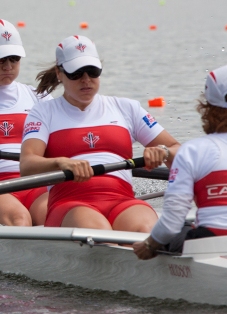Rowers: Get a Grip!
Watching a crew row by, one’s technical eye will typically spot the slow catches from the faster ones, inconsistent blade work and maybe even the body movements that are out of sync. Yet, I think the coach should not be totally responsible for influencing the change of a quicker catch or improved timing. It seems to me the rower should also take the responsibility of correcting these flaws.

A rower has two points of contact with the water: the feet and the hands. The first are the feet, since force generated from the movement of the hips, legs and back is transferred through the foot stretchers from the toes to the heels. This force is simultaneously transferred to the oar by the athlete’s grip with her hands, and if it weren’t for this connection to the tool of propulsion, a boat wouldn’t move very far or fast. This second point of attachment, the hands, is one of those technical points that an athlete can easily self coach. A better grip and a better feel for the blade through the hands will undeniably lead to a more effective connection through the water.
My first tip is relaxed hands and a loose grip. Of course, it’s easier said than done! However, it is far easier for rowers to feel than it is for the coaches to see. Rowers should focus on how the handle rolls in the palm of their outside hands as they approach the catch. Also, rowers should take a look at the hands at the catch and make sure they don’t have white knuckles. A tight grip will only lead to a “hammer-the-catch” type of stroke! By maintaining a looser grip, even in rough water, I believe that a rower can achieve a smoother and quicker pick-up at the catch. From afar, coaches will notice the faster catch but won’t necessarily attribute it to the relaxed hands.
My second tip is hand positioning. Often in boats you will see some athletes with a grip wider than their own shoulders and others will have a narrow grip. A wider grip will allow you a greater pivot at the catch while a narrow grip will limit your pivot. At both extremes, the stroke is not at optimal efficiency. Therefore, rowers should be extremely conscious of their hand placements and be sure that as the workout progresses the inside hand doesn’t move up and down the grip. A cue to help rowers correct the width of their grips is to place a rubber band on the grip at the ideal inside hand position. When the rower’s hand comes in contact with the band, she will know that her hand has shifted. Again, this is a technical flaw difficult for coaches to spot, as they have to be at a 45-degree angle to the boat to see it.
Last, but not least, a rower’s hands should only barely brush against her body at the release. Under no circumstance should the handle come in contact with the body, since it would be like slamming on the hand break—killing all the momentum of the boat generated through the drive. Skin abrasions and bruises on the torso are obvious hints that there is too much contact between the handle and the body. Again, rowers can use their feel to correct this movement at the finish. The focus should be that the handle brushes against the body once the blade is out of the water and the hands are leaving the bow. Here we go, we’ve come full circle—a loose grip and good handle control will allow the rower to smooth out the release!
To wrap it up, a rower’s two most important points of contact with the water are the feet and hands, yet coaches have limited sight of both of those areas. Learning to feel the mechanics of the hands and how the grips affects the stroke will help rowers get a more efficient grip on the water!
